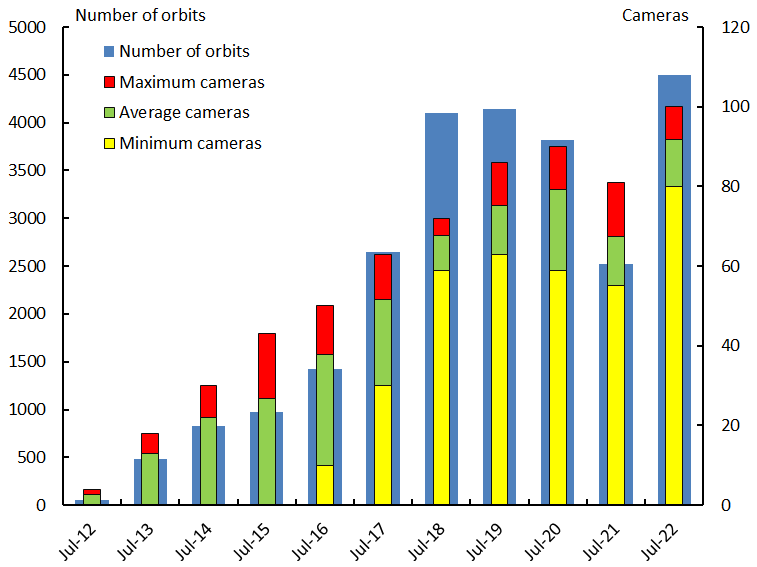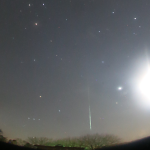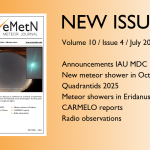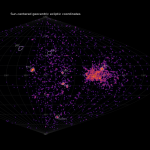Abstract: A summary of the activity of the CAMS BeNeLux network during the month of July 2022 is presented. July 2022 allowed to register 29558 meteors of which 15972 multiple-station meteors, with a total number of 4499 orbits. A maximum of 100 cameras was operational at 30 camera stations during this month.
Introduction
Although a summer month, the weather in July is often unfavorable for astronomy in the BeNeLux area. The short nights with only about 6 hours of observing time are easily ruined by bad weather. The overall meteor activity increases significantly during this month with some well-established showers late July while Perseid activity becomes clearly visible. July 2018, 2019, and 2020 were all excellent months of July for our CAMS network, July 2021 was a very poor month. What would July 2022 bring?
July 2022 statistics
CAMS BeNeLux collected 29558 meteors of which 15972 were multi-station meteors, good for 4499 orbits (against 7125 multi-station meteors and 2525 orbits in July 2021). This is with distance the very best month of July ever for the network.
July 2022 brought plenty of clear nights while July 2021 got only few complete clear nights. Not a single night had zero orbits, while last two years July had each year three nights ending without any single orbit. 24 nights had more than 100 orbits (11 in 2021, 14 in 2020), 9 nights had more than 200 orbits (2 in 2021, 6 in 2020). July 29–30 was the most successful night with 385 orbits, which is still much less than the record July night of 30–31 July 2020 with 542 orbits or July 29–30 in 2019 with 504 orbits. The statistics of July 2022 are compared in Figure 1 and Table 1 with the same month in previous years since the start of CAMS BeNeLux in 2012. In 11 years, 278 July nights allowed to obtain orbits with a grand total of 25487 orbits collected during this month in all these years.
A new RMS camera (BE000D) has been installed by Steve Rau at Astropolis in Ostend, Belgium. The status of the network improved a lot compared to July 2021 when as many as 25 cameras at several CAMS stations in the Netherlands and Germany were not available for various reasons. In a video camera network, the success of each participant depends on the availability and goodwill of all others involved in order to obtain multi-station events. When a number of camera locations have no cameras running, this reduces the number of paired meteors.
A record number of 100 cameras were operational at best with on average 91.7 operational cameras and a minimum of 80. With more cameras available than ever before in July and exceptional good weather, a record number of meteors and orbits were obtained, although meteors detected below 25° were still taken into account in previous years but rejected by CAMS since 2022.

Figure 1 – Comparing July 2022 to previous months of July in the CAMS BeNeLux history. The blue bars represent the number of orbits, the red bars the maximum number of cameras capturing in a single night, the green bar the average number of cameras capturing per night and the yellow bar the minimum number.
Table 1 – July 2022 compared to previous months of July.
| Year | Nights | Orbits | Stations | Max. Cams | Min. Cams | Mean Cams |
| 2012 | 7 | 49 | 4 | 4 | – | 2.6 |
| 2013 | 22 | 484 | 10 | 18 | – | 12.9 |
| 2014 | 19 | 830 | 14 | 30 | – | 22.0 |
| 2015 | 28 | 976 | 15 | 43 | – | 26.7 |
| 2016 | 28 | 1420 | 18 | 50 | 10 | 37.9 |
| 2017 | 27 | 2644 | 20 | 63 | 30 | 51.6 |
| 2018 | 30 | 4098 | 19 | 72 | 59 | 67.7 |
| 2019 | 30 | 4139 | 21 | 86 | 63 | 75.2 |
| 2020 | 28 | 3823 | 24 | 90 | 59 | 79.1 |
| 2021 | 28 | 2525 | 27 | 81 | 55 | 67.3 |
| 2022 | 31 | 4499 | 30 | 100 | 80 | 91.7 |
| Total | 278 | 25470 |
Table 2 lists the 20 best performing cameras in the network in terms of orbits. Note the scores of the RMS cameras. Note the difference in scores between CAMS and GMN, with the GMN trajectory rejecting more unfavorable geometrics than CAMS, but not blindly rejecting everything below 25° elevation.
Table 2 – Comparing RMS cameras among the twenty cameras of the CAMS BeNeLux network with the best score in terms of orbits during July 2022.
| Camera | Orbits CAMS | Nights CAMS | Orbits GMN |
| 003825 RMS, Dourbes, B | 695 | 30 | 643 |
| 003821 RMS, Humain, B | 690 | 30 | 665 |
| 003826 RMS, Lesve, B | 561 | 31 | 403 |
| 003814 RMS, Grapfontaine, B | 531 | 31 | 336 |
| 003853 RMS, Zillebeke, B | 413 | 31 | 271 |
| 003816 RMS, Lesve, B | 379 | 30 | 233 |
| 003817 RMS, Grapfontaine, B | 376 | 31 | 522 |
| 003851 RMS, Zillebeke, B | 296 | 31 | 225 |
| 003827RMS, Zoersel, B | 275 | 31 | 226 |
| 003818 RMS, Genk, B | 271 | 31 | 126 |
| 003819 RMS, Genk, B | 269 | 31 | 329 |
| 003833 Watec, Mechelen, B | 261 | 31 | – |
| 000805 Watec, Zoersel, B | 258 | 31 | – |
| 003837 Watec, Mechelen, B | 245 | 31 | – |
| 000814 Watec, Grapfontaine, B | 243 | 31 | – |
| 003834 Watec, Mechelen, B | 241 | 31 | – |
| 003832 Watec, Mechelen, B | 232 | 31 | – |
| 000395 Watec, Dourbes, B | 230 | 31 | – |
| 000815 Watec, Grapfontaine, B | 230 | 30 | – |
| 003890 Watec, Mechelen, B | 229 | 29 | – |
Conclusion
July 2022 became the most successful month of July in the CAMS BeNeLux history with a record number of meteors recorded and orbits obtained.
Acknowledgment
Many thanks to all participants in the CAMS BeNeLux network for their dedicated efforts. The data on which this report is based has been taken from the CAMS website. The CAMS BeNeLux team is operated by the following volunteers:
Hans Betlem (Woold, CAMS 3071, 3072 and 3073), Jean-Marie Biets (Wilderen, Belgium, CAMS 379, 380, 381 and 382), Ludger Boergerding (Holdorf, Germany, RMS 3801), Martin Breukers (Hengelo, Netherlands, CAMS 320, 321, 322, 323, 324, 325, 326 and 327, RMS 319, 328 and 329), Seppe Canonaco (Genk, RMS 3818, RMS 3819), Pierre de Ponthiere (Lesve, Belgium, RMS 3816 and 3826), Bart Dessoy (Zoersel, Belgium, CAMS 397, 398, 804, 805, 806, 888 and RMS 3827), Tammo Jan Dijkema (Dwingeloo, Netherlands, RMS 3199), Isabelle Ansseau, Jean-Paul Dumoulin, Dominique Guiot and Christian Walin (Grapfontaine, Belgium, CAMS 814 and 815, RMS 3814, RMS 3817), Uwe Glässner (Langenfeld, Germany, RMS 3800), Luc Gobin (Mechelen, Belgium, CAMS 3890, 3891, 3892 and 3893), Tioga Gulon (Nancy, France, CAMS 3900 and 3901), Robert Haas (Alphen aan de Rijn, Netherlands, CAMS 3160, 3161, 3162, 3163, 3164, 3165, 3166 and 3167), Robert Haas (Texel, Netherlands, CAMS 810,811, 812, 813), Robert Haas (Burlage, Germany, RMS 3803, 3804), Kees Habraken (Kattendijke, Netherlands, RMS 378), Klaas Jobse (Oostkapelle, Netherlands, CAMS 3030, 3031, 3032, 3033, 3034, 3035, 3036 and 3037), Carl Johannink (Gronau, Germany, CAMS 3100, 3101, 3102, 3103, 3104 and 3105), Reinhard Kühn (Flatzby, Germany, RMS 3802), Hervé Lamy (Dourbes, Belgium, CAMS 394 and 395, RMS 3825), Hervé Lamy (Humain Belgium, CAMS 816, RMS 3821), Hervé Lamy (Ukkel, Belgium, CAMS 393), Koen Miskotte (Ermelo, Netherlands, CAMS 3051 and 3052), Jos Nijland (Terschelling, Netherlands, CAMS 841, 842, 844), Tim Polfliet (Gent, Belgium, CAMS 396, RMS 3820), Steve Rau (Oostende, Belgium, RMS 3822), Steve Rau (Zillebeke, Belgium, CAMS 3850, 3852, RMS 3851, RMS 3853), Paul and Adriana Roggemans (Mechelen, Belgium, RMS 3830 and 3831, CAMS 3832, 3833, 3834, 3835, 3836 and 3837), Jim Rowe (Eastbourne, UK, RMS 3829), Hans Schremmer (Niederkruechten, Germany, CAMS 803), Erwin van Ballegoij (Heesch, Netherlands, CAMS 3148).




